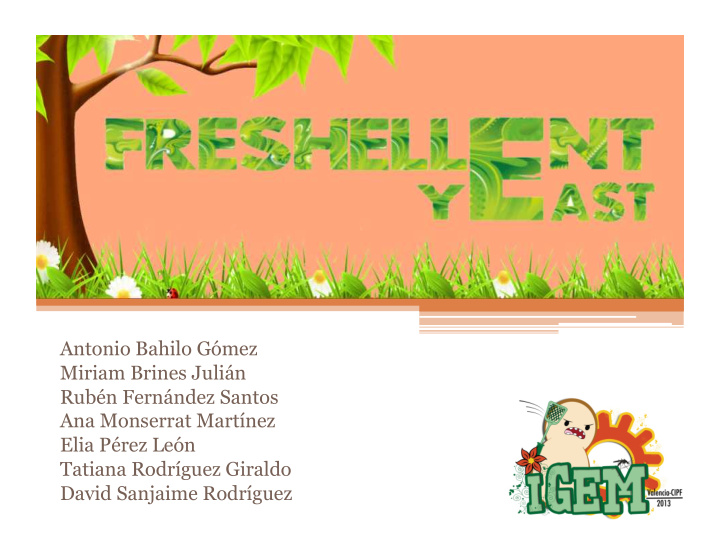



Antonio Bahilo Gómez Miriam Brines Julián Rubén Fernández Santos Ana Monserrat Martínez Elia Pérez León Tatiana Rodríguez Giraldo David Sanjaime Rodríguez
Introduction • Team: 7 students from Valencia • Worktime PROBLEM Diseases transmited by insects like malaria or sleeping sickness SOLUTION Creating a yeast capable of repelling these insects materials and introduction aim results conclusion methods
Aim Create a biological platform • AROMA 1 within common yeast to develop linalool synthase from Clarkia a device capable of producing breweri (Dudareva et al., several monoterpenoids acting 1996) – M. Orejas like aromas and repellents • AROMA 2 geraniol synthase from Ocimum basilicum • REPELLENT 1,8-cineole synthase from Arabidopsis thaliana (Demissie et al., 2012) 1,8-cineole geraniol S-linalool materials and introduction aim results conclusion methods
materials and introduction aim results conclusion methods
Inducible promoter Cup1: linalool synthase Inducible promoter H 2 O 2 : geraniol synthase materials and introduction aim results conclusion methods
S-linalool synthase • Parts registry: BBa_M11053. http://parts.igem.org/ • From Clarkia breweri Part:BBa_M11053:Design? • GPP S-linalool title=Part:BBa_M11053:Design • 2760 bp • Restriction enzymes • mRNA linear incompatibilities: EcoRI, XbaI, BglII, XhoI. materials and introduction aim results conclusion methods
Materials and methods WET LAB DRY LAB • Raw material: LIS in ER85 • Genome-scale metabolic models to estimate the • Amplification using PCR (TOPO behavior of the organism. vector to increase the concentration) • Organism metabolism • Digestion of LIS by BamHI and modeled by a network of SalI metabolites and enzymes that • Ligation into pYEX-4T must integrate all biochemical • Transformation into S. reactions present in the cerevisiae ERG20 K197G organism. • Flux Balance Analysis (FBA) materials and introduction aim results conclusion methods
Results WET LAB • Starting from the initial objectives, good results were not achieved in geraniol synthase and 1,8- cineole synthase. They could not be cloned in their respective plasmids neither expressed in yeast. In the first case, the cDNA could not be obtained; in the second one, the gene could not be amplified from the A. thaliana cDNA. • LIS was transformed into S. cerevisiae . No experiments were performed due to time limitation materials and introduction aim results conclusion methods
DRY LAB • GPP was excreted into the medium. • Production of GPP by ERG20 • Simulation in steady-state higher than in the classical strain conditions accumulation • Decreasing yeast growth excess of GPP • If the yeast was modified to diminish its growth more GPP • Point of optimal growth production value for our reaction of GPP is zero (all is used to grow) • The points near to the optimum have higher accuracy, since they are closer to the point validated experimentally materials and introduction aim results conclusion methods
Conclusions • S. cerevisiae ERG20 K197G is a good biologic device • Extra experiments could have been performed: - Optimal concentration of copper for the expression - Time needed after the addition of copper to observe expression of the gene - Measuring how the expression varies depending on the concentration of copper materials and introduction aim results conclusion methods
Human practices and others • Survey about the impact of our project on society Did you know that Saccharomyces is frequently used in research in the field of biology and health sciences? General opinions about transgenic organisms. Opinion about modified organisms.
• Lipdub to promote science
• Lab practices with teenagers
References • Butt, T. R., Sternberg, E. J., Gorman, J. A., Clark, P., Hamer, D., Rosenberg, M., & Crooke, S. T. (1984). Copper metallothionein of yeast, structure of the gene, and regulation of expression. Proceedings of the National Academy of Sciences, 81(11), 3332-3336. • Chen, F., Ro, D. K., Petri, J., Gershenzon, J., Bohlmann, J., Pichersky, E., & Tholl, D. (2004). Characterization of a root-specific Arabidopsis terpene synthase responsible for the formation of the volatile monoterpene 1, 8-cineole. Plant Physiology. • Dudareva, N., Cseke, L., Blanc, V. M., and Pichersky, E.(1996) Evolution of floral scent in Clarkia : Novel patterns of S-linalool synthase gene expression in the C. breweri flower Plant Cell, 8, 1137-1148. • Förster J., Famili I., Fu P., Palsson B. Ø., and Nielsen J., 2003, “Genome-scale reconstruction of the Saccharomyces cerevisiae metabolic network.,” Genome Res., 13(2), pp. 244–53. • Fischer, M. J., Meyer, S., Claudel, P., Bergdoll, M., & Karst, F. (2011). Metabolic engineering of monoterpene synthesis in yeast. Biotechnology and bioengineering, 108(8), 1883-1892. • Mascorro-Gallardo, J. O., Covarrubias, A. A., & Gaxiola, R. (1996). Construction of a CUP1promoter-based vector to modulate gene expression in Saccharomyces cerevisiae . Gene, 172(1), 169-170. • Pichersky E, E Lewinsohn, R Croteau. Purification and characterization of S-linalool synthase, an enzyme involved in the production of floral scent in Clarkia breweri . Arch Biochem Biophys. 316:803-807. (1995). • Thiele I., and Palsson B. Ø., 2010, “A protocol for generating a high-quality genome-scale metabolic reconstruction.,” Nat. Protoc., 5(1), pp. 93–121. • Orth J. D., Thiele I., and Palsson B. Ø., 2010, “What is flux balance analysis?,” Nat. Biotechnol., 28(3), pp. 245–8. •
Recommend
More recommend